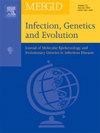Molecular assessment of carbapenem-resistant and ESBL Klebsiella pneumoniae clinical isolates to decipher the correlation of antimicrobial resistance with virulence traits
IF 2.6
4区 医学
Q3 INFECTIOUS DISEASES
引用次数: 0
Abstract
Klebsiella pneumoniae is a nosocomial pathogen that poses a serious concern due to the high prevalence of extended-spectrum beta-lactamases (ESBL) and carbapenem-resistant K. pneumoniae (CRKP) strains. However, the data on the prevalence of contributing virulence determinants are limited in the Pakistani population. The study aims to characterize clinical isolates of K. pneumoniae to understand clonal relationships and determine the relationship of antibiotic resistance with different virulence factors (i.e., biofilm, capsular polysaccharide, hemolysis, efflux pump, and outer membrane porins). The clinical strains were collected from the diagnostic facility of two public sector hospitals in Karachi. The resistance and virulence profile of the isolates were evaluated via antibiotic susceptibility test, double disk synergy test (DDST), ChromAgar, string test, blood hemolysis, and biofilm assay. Genotypically, the isolates were identified by 16S rRNA and rpoB gene, and further characterized for the presence of ESBL, CRKP, biofilm, efflux pump, and outer membrane porins genes. The clonal lineage among isolates was established by Enterobacterial Repetitive Intergenic Consensus Polymerase Chain Reaction (ERIC PCR). The antibiotic susceptibility test was analyzed through the Multiple Antibiotic Resistance (MAR) index, which revealed 90.2 % (n = 102) strains were MDR. Whereas, the genetic diversity was revealed through ERIC PCR and clade wise data revealed genetic variations due to ESBL (85 %), carbapenem resistance (73 %), biofilm (97 %), efflux pump (40–53 %), outer membrane porins (38–49 %), and hypermucoidity (6 %). The Pearson correlation analysis revealed a strong relationship of MDR strains with biofilm (r = 0.99), efflux pump (r = 0.92), and outer membrane porins (r = 0.88). The study highlighted the prevalence of MDR K. pneumonia with the plethora of virulence factors in the local clinical setting, necessitating stringent screening to develop national policies to tackle further antimicrobial resistance development and outbreaks.
碳青霉烯耐药和ESBL肺炎克雷伯菌临床分离株的分子鉴定,以揭示耐药性与毒力性状的相关性
肺炎克雷伯菌是一种医院病原体,由于广谱β -内酰胺酶(ESBL)和耐碳青霉烯肺炎克雷伯菌(CRKP)菌株的高发,引起了严重关注。然而,在巴基斯坦人口中,有关致病决定因素流行率的数据有限。本研究旨在对临床分离的肺炎克雷伯菌进行表征,了解克隆关系,确定不同毒力因子(生物膜、荚膜多糖、溶血、外排泵、外膜孔蛋白)与抗生素耐药性的关系。临床菌株是从卡拉奇两家公立医院的诊断设施收集的。采用药敏试验、双盘协同试验(DDST)、ChromAgar、串珠试验、溶血试验和生物膜试验评价分离菌株的耐药性和毒力。基因特征上,分离菌株通过16S rRNA和rpoB基因进行鉴定,并进一步鉴定存在ESBL、CRKP、生物膜、外排泵和外膜孔蛋白基因。采用肠杆菌重复基因间一致聚合酶链反应(ERIC PCR)建立了分离株的克隆谱系。通过多重抗生素耐药(MAR)指数进行药敏试验,结果显示90.2% (n = 102)菌株为MDR。然而,通过ERIC PCR揭示了遗传多样性,进化类数据显示遗传变异是由于ESBL(85%)、碳青霉烯类耐药性(73%)、生物膜(97%)、外排泵(40 - 53%)、外膜孔蛋白(38 - 49%)和高粘液性(6%)。Pearson相关分析显示,MDR菌株与生物膜(r = 0.99)、外排泵(r = 0.92)和外膜孔蛋白(r = 0.88)有较强的相关性。该研究强调了耐多药克雷伯菌肺炎的流行,在当地临床环境中存在过多的毒力因素,需要进行严格的筛查,以制定国家政策,以应对进一步的抗菌素耐药性发展和暴发。
本文章由计算机程序翻译,如有差异,请以英文原文为准。
求助全文
约1分钟内获得全文
求助全文
来源期刊

Infection Genetics and Evolution
医学-传染病学
CiteScore
8.40
自引率
0.00%
发文量
215
审稿时长
82 days
期刊介绍:
(aka Journal of Molecular Epidemiology and Evolutionary Genetics of Infectious Diseases -- MEEGID)
Infectious diseases constitute one of the main challenges to medical science in the coming century. The impressive development of molecular megatechnologies and of bioinformatics have greatly increased our knowledge of the evolution, transmission and pathogenicity of infectious diseases. Research has shown that host susceptibility to many infectious diseases has a genetic basis. Furthermore, much is now known on the molecular epidemiology, evolution and virulence of pathogenic agents, as well as their resistance to drugs, vaccines, and antibiotics. Equally, research on the genetics of disease vectors has greatly improved our understanding of their systematics, has increased our capacity to identify target populations for control or intervention, and has provided detailed information on the mechanisms of insecticide resistance.
However, the genetics and evolutionary biology of hosts, pathogens and vectors have tended to develop as three separate fields of research. This artificial compartmentalisation is of concern due to our growing appreciation of the strong co-evolutionary interactions among hosts, pathogens and vectors.
Infection, Genetics and Evolution and its companion congress [MEEGID](http://www.meegidconference.com/) (for Molecular Epidemiology and Evolutionary Genetics of Infectious Diseases) are the main forum acting for the cross-fertilization between evolutionary science and biomedical research on infectious diseases.
Infection, Genetics and Evolution is the only journal that welcomes articles dealing with the genetics and evolutionary biology of hosts, pathogens and vectors, and coevolution processes among them in relation to infection and disease manifestation. All infectious models enter the scope of the journal, including pathogens of humans, animals and plants, either parasites, fungi, bacteria, viruses or prions. The journal welcomes articles dealing with genetics, population genetics, genomics, postgenomics, gene expression, evolutionary biology, population dynamics, mathematical modeling and bioinformatics. We also provide many author benefits, such as free PDFs, a liberal copyright policy, special discounts on Elsevier publications and much more. Please click here for more information on our author services .
 求助内容:
求助内容: 应助结果提醒方式:
应助结果提醒方式:


